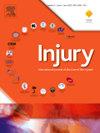输血和手术治疗会增加肱骨近端骨折患者的死亡率。
IF 2.2
3区 医学
Q3 CRITICAL CARE MEDICINE
Injury-International Journal of the Care of the Injured
Pub Date : 2023-12-01
DOI:10.1016/j.injury.2023.111091
引用次数: 0
摘要
简介:肱骨近端骨折(PHF)经常发生在患有骨质疏松症和相关合并症的老年患者身上。这些患者构成了一个特殊的风险群体。本研究旨在确定合并症、治疗类型和死亡风险之间的关联:我们对 350 名确诊为 PHF 的患者进行了回顾性病历审查,平均随访时间为 4.5 年。我们分析了查尔森合并症指数(CCI)中包含的 19 种骨折前合并症、血红蛋白(Hb)水平、输血需求和治疗方法(手术与保守)。采用非参数 Kaplan-Meier 法和 Cox 比例危险模型估算死亡风险:在对 350 名肱骨近端骨折患者(主要是老年女性)进行的平均为期 4.5 年的随访中,有几个因素与死亡率的增加有关。夏尔森综合症指数(CCI)是一个重要的预测因素,CCI>5的患者面临更高的死亡风险,尤其是接受手术的患者。此外,与关节置换术相比,骨合成术的死亡率较低。年龄、痴呆症、内科并发症和骨折后血红蛋白水平也会影响死亡率。结论:这些研究结果强调了考虑合并症,特别是夏尔森合并症指数(CCI)对确定患者预后的重要性,尤其是肱骨近端骨折的老年患者。年龄、痴呆症和骨折后血红蛋白水平等因素也是影响死亡率的关键因素:该研究获得了地区临床研究伦理委员会的书面批准(代码 2016/125)。本文章由计算机程序翻译,如有差异,请以英文原文为准。
Blood transfusion and surgical treatment increase mortality in patient with proximal humeral fractures
Introduction
Proximal humeral fractures (PHFs) often occur in elderly patients with osteoporosis and associated comorbidities. These patients constitute a special risk group. This study aimed to identify associations between comorbidities, treatment type, and mortality risk.
Patients and Methods
We conducted a retrospective chart review of a cohort of 350 patients with a diagnosis of PHF and a mean follow-up of 4.5 years. We analysed the 19 prefracture comorbidities included in the Charlson Comorbidity Index (CCI), haemoglobin (Hb) levels, blood transfusion needs, and treatment administered (surgery versus conservative). The nonparametric Kaplan–Meier method and Cox proportional hazards model were used to estimate the mortality risk.
Results
Over a 4.5-year average follow-up of 350 patients, primarily elderly females, with proximal humerus fractures, several factors were associated with increased mortality. The Charlson Comorbidity Index (CCI) was a significant predictor, with patients having a CCI > 5 facing higher mortality risks, especially if they underwent surgery. Additionally, osteosynthesis was linked to a lower mortality rate compared to arthroplasty. Age, dementia, medical complications, and postfracture Hb level also influenced mortality rates.
Conclusión
These findings emphasize the importance of considering comorbidities, specifically the Charlson Comorbidity Index (CCI), in determining patient outcomes, especially amongst elderly patients with proximal humerus fractures. Factors like age, dementia, and postfracture Hb level also play a crucial role in influencing mortality rates.
Trial registration
The study received written approval from the regional Ethics Committee for Clinical Research (code 2016/125).
求助全文
通过发布文献求助,成功后即可免费获取论文全文。
去求助
来源期刊
CiteScore
4.00
自引率
8.00%
发文量
699
审稿时长
96 days
期刊介绍:
Injury was founded in 1969 and is an international journal dealing with all aspects of trauma care and accident surgery. Our primary aim is to facilitate the exchange of ideas, techniques and information among all members of the trauma team.

 求助内容:
求助内容: 应助结果提醒方式:
应助结果提醒方式:


